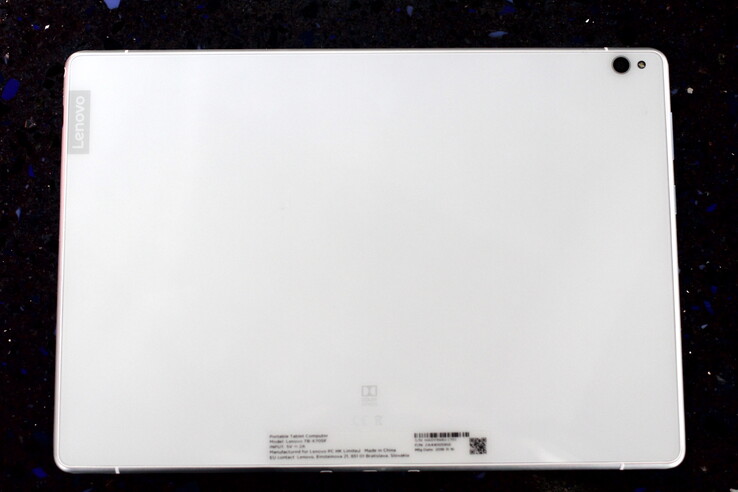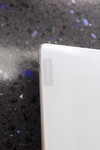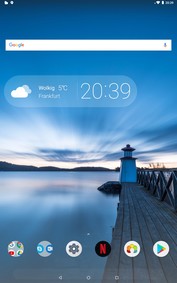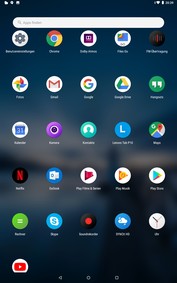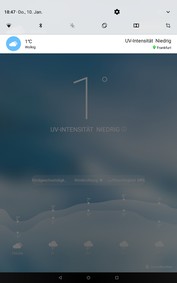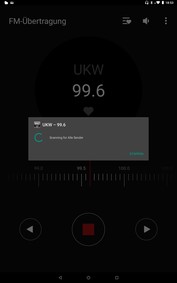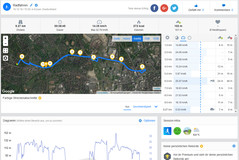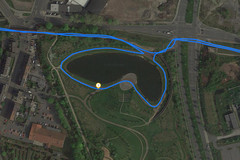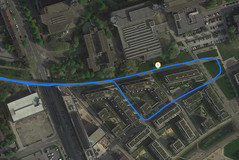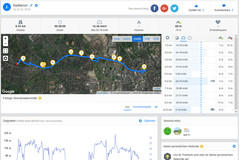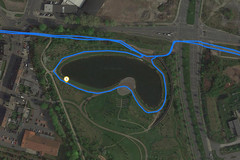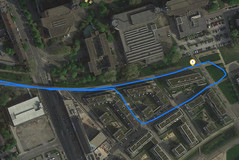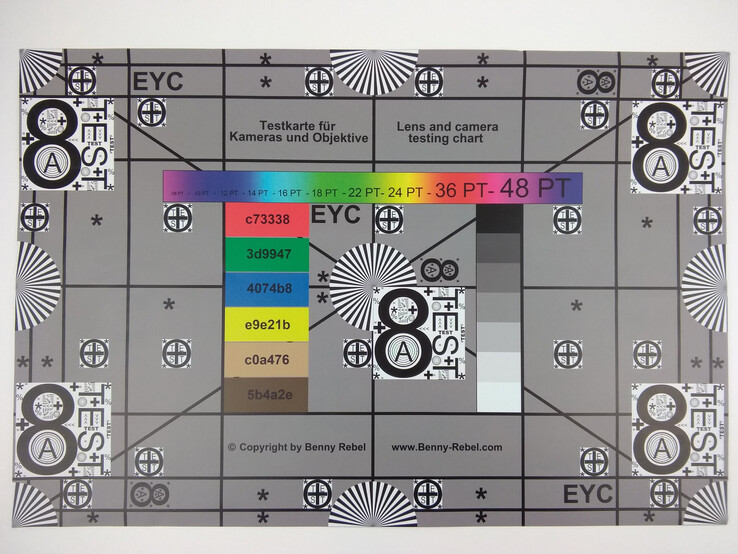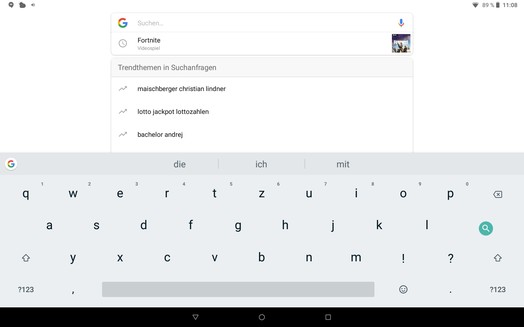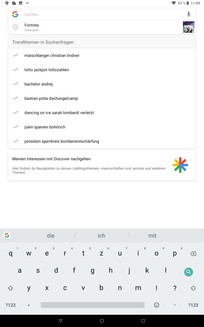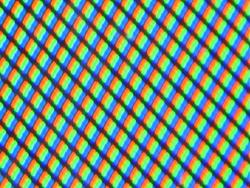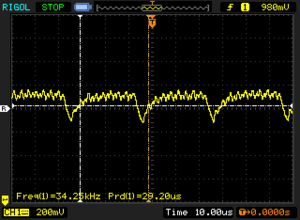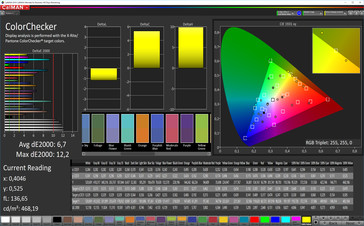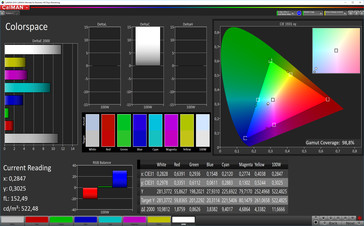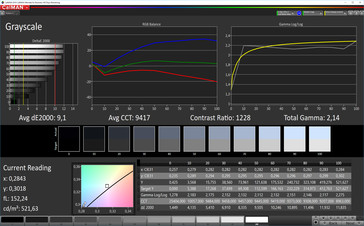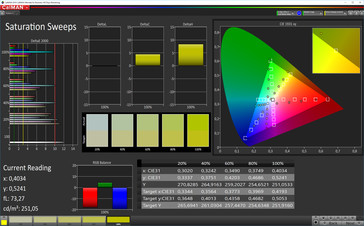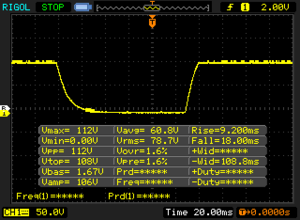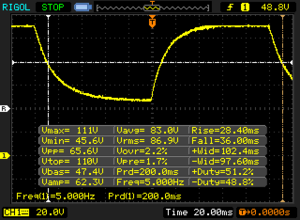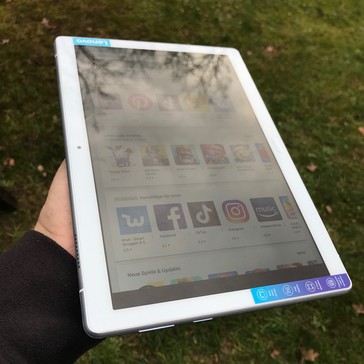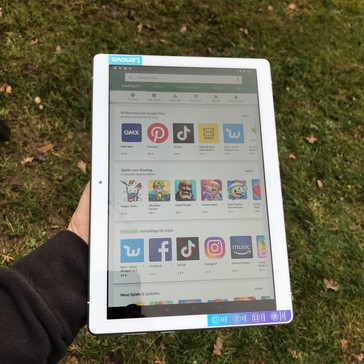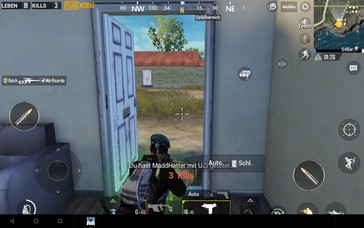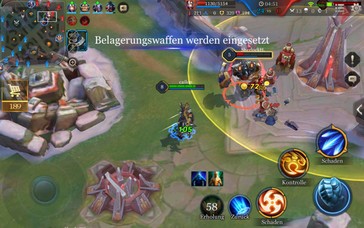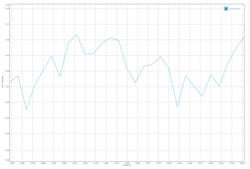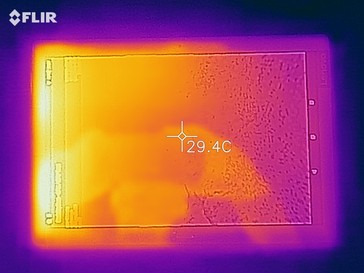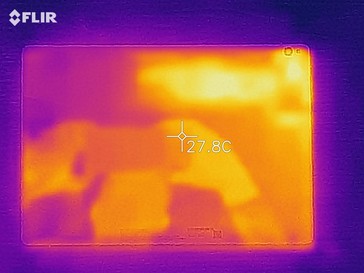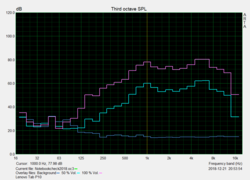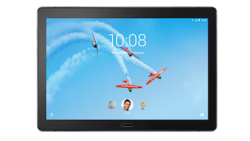Lenovo Tab P10 Tablet Review
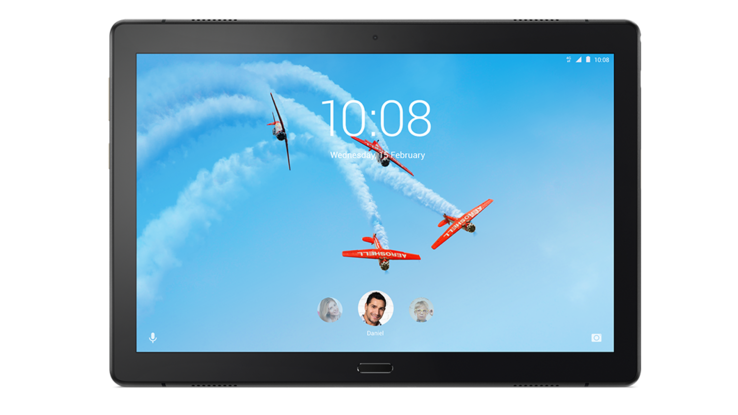
The Tab P10 is one of two tablets that Lenovo sells in a bundle with its new Smart Dock. The second tablet, the Lenovo Tab M10, is a cheaper alternative to the Tab P10. The Tab M10, for example, has two speakers compared to the Tab P10’s four. Correspondingly, the Tab M10 costs between 199 and 249 Euros (~$226 and $282), which is 100 Euros (~$113) cheaper than the Tab P10 currently costs.
It is worth noting that Lenovo markets the tablets as the Smart Tab M10 and the Smart Tab P10 when they are bought with the Smart Dock, but they are identical to the regular Tab M10 and P10. Moreover, both bundles are currently the same price as Lenovo initially charged for just the tablets, so it remains to be seen whether the company will somehow reward its early adopters. The bundles officially launch on January 25, but there appear to be no plans for Lenovo to sell the Smart Dock separately.
Lenovo markets the Tab series as being family friendly unlike its Windows-based Tablet 10 or its ThinkPad tablets. Each member of the family can create a profile on the Tab P10 and unlock the device with their fingerprints. Lenovo has included a children’s account too, which allows the device to be unlocked without a fingerprint and incorporates numerous child-friendly features that parents can set and customise.
The Tab P10 is not powerful enough to compete against the current best Android tablets like the Huawei MediaPad M5 10.8 Pro or the Samsung Galaxy Tab S4, so we have chosen to compare our test device against other comparably priced Android tablets instead. Our comparison devices include the Chuwi HiPad, the Hi9 Plus, the Huawei MediaPad T5 , the MediaPad M5 10.8 and the Samsung Galaxy Tab A. Please keep in mind that our Chuwi comparison devices are considerably cheaper than the Tab P10.
Case
The Tab P10 certainly looks expensive with its glass back and its metal frame. The frame has a chamfered edge too, which belies the tablet’s affordable pricing. The Tab P10 has four speakers that are distributed across the top and underside of the frame, while it also lies flat on a table with its rear-facing camera protected behind the back glass. The tablet has a clean look to it with subtle Dolby and Lenovo logos beneath the back glass. Our test device is covered in stickers though, which detract from the minimalist styling.
Our test device is well made, but we could twist it slightly with our hands. The Tab P10 weighs 440 g and is 7 mm thick, which makes the device lighter and thinner than all our comparison devices. The Tab P10 is 40 g lighter and 1 mm slimmer than the Tab M10 too.
Connectivity
There are several versions of the Tab P10, of which all are equipped with a Qualcomm Snapdragon 450 SoC. Our test device is the Wi-Fi version with 4 GB RAM and 64 GB of storage, but Lenovo also sells a model with 3 GB RAM and 32 GB of storage. There is also an LTE version should you need constant Internet connectivity. We have included a table below giving an overview of the models available and their pricing at the time of writing.
| Device | Connectivity | RAM | Storage | Price |
|---|---|---|---|---|
| Lenovo Tab P10 | Wi-Fi | 3 GB | 32 GB | €299 (~ US$339) |
| Lenovo Tab P10 | Wi-Fi & LTE | 3 GB | 32 GB | €349 (~ US$396) |
| Lenovo Tab P10 | Wi-Fi | 3 GB | 32 GB | €349 (~ US$396) |
| Lenovo Tab P10 | Wi-Fi & LTE | 4 GB | 64 GB | €399 (~ US$453) |
Our test device is the 4 GB/64 GB version with Wi-Fi, which is better equipped than many of our comparison devices. By contrast, only the Hi9 Plus matches the Tab P10 on storage and RAM, while the Hi9 and the two Huawei tablets come with a maximum of 32 GB storage. The Tab P10 also supports up to 256-GB microSD cards and can format cards as internal storage, which gives the device plenty of additional space on which to store apps and data.
Lenovo has equipped the tablet with a USB 2.0 Type-C port for charging and data transfers along with a 3.5 mm headphone jack. The two ports sit next to each on the right-hand side of the frame, but there should be enough space between them for you to charge the device and listen to music over wired headphones or external speakers simultaneously without any cables clashing.
The tablet also has quad speakers and an FM radio tuner, although it does not support RDS or RBDS. Additionally, there is a fingerprint sensor on the front of the device and a set of pogo pins for connecting the tablet to the Lenovo Smart Dock.
Software
The Tab P10 ships with Android 8.1 Oreo at the time of writing, while Lenovo had updated our test device to only August 5, 2018 Android security patches. The patches were outdated by around four to five months during our tests, which is disappointing.
The UI is close to stock Android including opening the app drawer by swiping up from the bottom of the screen. Lenovo includes an option in Settings to disable the app drawer too, which then distributes app icons on your home screens as iOS does.
Lenovo also replaces some Google applications with its own like the contacts and camera apps. However, the company has opted to preinstall Google Files instead of its long maintained in-house file manager. Our test device also has third-party apps preinstalled too like Netflix, a radio app and SyncIt HD, a proprietary backup software. We could uninstall the latter two apps, but we had no such luck with the Netflix app, which could only be deactivated within Settings.
There are few additional settings that are not present on stock Android too. Lenovo has included its quicker app switcher that we have seen on Yoga Tablets, which adds a row of open apps at the bottom of the screen for quickly switching and closing apps without needing to launch Recents. Its execution on our test device is poor though as icons for apps that we have closed remain at the bottom of the display. Tapping the closed apps does nothing, so hopefully Lenovo can fix this in an update.
There is also a do not disturb mode while playing games, which is useful. Switching it on silences all notifications except alarms and important battery alerts, although you must manually select to which games the mode applies.
Speaking of notifications, our test unit has a weather app notification bug. The notification for the default weather app always sits at the top of our notifications and cannot be dismissed, which is frustrating. Disabling the app would resolve this, but you would lose the weather widget, so hopefully Lenovo can fix this in an update.
Communication & GPS
The Tab P10 supports all modern Wi-Fi standards up to IEEE 802.11ac and can connect to 2.4 GHz or 5 GHz networks. Our test unit performed well in our iperf3 Client Wi-Fi tests, where it finished top of the transmission test. By contrast, it finished joint fourth in the other test, but only 2 Mb/s behind the Galaxy Tab A in third place.
Our test device also maintained its Wi-Fi connection when placed far from the router, although its reception dropped significantly. The tablet supports Bluetooth 4.2 for near-field communications too.
It takes a while for our test unit to find a satellite fix, but it eventually does so with up to 5 metres accuracy when we tested it outside. Predictably, the GPS accuracy drops considerably inside, but at least it manages to maintain a sat fix, which not all devices can.
We also subjected the Tab P10 to a bike ride to test its location accuracy against our reference navigation system, the Garmin Edge 500. Our test device performed well over the 9.33 km bike ride that the Garmin recorded us having cycled and only deviated by 60 metres. However, the tablet did a good job overall as demonstrated by the screenshots below, although it occasionally plotted us on the wrong side of the road on which we were cycling.
Cameras
Lenovo has equipped the Tab P10 with a 5 MP front-facing camera that has a fixed focus and an 8 MP rear-facing sensor. The main camera is complemented by an LED flash and supports HDR, panoramic photos and various filters. The filters switch off HDR mode though.
The filters are also ineffective. The sketch filter produces photos that lack details in dark areas, as demonstrated by the photo below. Moreover, photos shot with the Tab P10 look noticeably darker than those taken with the Apple iPhone XS, Sony Xperia XZ2 Premium or our SLR camera. Granted, these devices are considerably more expensive than the Tab P10, but it underlines the poor-quality optics with which Lenovo has equipped the tablet. The difference is particularly noticeable in scene 2, where dark areas are underexposed by our test unit to the point where details are completely lost. Additionally, we noticed that photos shot with the Tab P10 have a slight red tint to them, which is something worth keeping in mind before taking photos with the device.
We also subjected the rear-facing camera to more tests under controlled lighting conditions during which we analyse its ability to reproduce colours accurately and how well it photographs our test chart. The Tab P10 generally did a good job at reproducing colours compared to the ColorChecker Passport reference colours, although grey and white tones are replicated too darkly.
The Tab P10 also captured our test chart sharply, although the chart looks noticeably blurrier towards the edges of the picture. Moreover, the contrast levels drop off too, while colour look rather washed out and the rear-facing camera struggles to reproduce black text on brown backgrounds.
Accessories & Warranty
The Tab P10 comes with two-year limited manufacturer’s warranty and one year’s warranty for its battery. Lenovo includes a charger, a USB cable, a card slot tool, a quick-start guide, and warranty information in the box too. Please see our Guarantees, Return policies and Warranties article for country-specific information.
The tablet also works with the Lenovo Smart Dock, which the Tab P10 connects to via its pogo pins. The dock has two speakers and three far-field microphones, which turns the tablet into a quasi-smart screen with Amazon Alexa functionality. Lenovo currently only sells the dock as part of a bundle with the Tab P10, and it remains to be seen whether the company will sell the dock separately for those have bought the tablet on its own.
Input Devices & Operation
Lenovo has preinstalled Google Gboard as the default keyboard on the Tab P10, which functions just as well as it does on other devices that we have tested. The touchscreen worked perfectly throughout testing too, while the glass is smooth enough to perform scrolling and swiping movements easily. The glass may be slightly too resistive for playing games that require fast swiping movements though.
The Tab P10 also has a fingerprint sensor that allows each user to register up to five fingerprints. The sensor registered our fingers quickly during our tests, but it then occasionally took two or three attempts before the sensor would accept our fingerprint. Hence, the registration process could do with some refining.
Display
The Tab P10 has a 10.1-inch IPS display that operates natively at 1920x1200 in a 16:10 aspect ratio. The screen has a 224 PPI pixel density, which is much lower than the displays in modern smartphones but is on par with comparable tablets.
Our test unit achieved an average maximum brightness of 495 cd/m², according to X-Rite i1Pro 2 and 522 cd/m² at the centre of the display, which is brighter than all but the Galaxy Tab A of our comparison devices. The display is only 84% evenly lit though, which puts the Tab P10 bottom of our comparison table in this regard.
Lenovo does not include any colour profiles or white balance options to adjust the colour temperature, but there is a blue-light filter that should help to reduce eye strain when using the tablet at night. Additionally, you can set the filter to come at certain times or according to changing ambient light. The filter also turns on automatically when the device is logged into a child profile. It is worth bearing in mind that the intensity of the filter must be set manually and does not adjust automatically like Apple’s True Tone Display.
| |||||||||||||||||||||||||
Brightness Distribution: 84 %
Center on Battery: 522 cd/m²
Contrast: 1273:1 (Black: 0.41 cd/m²)
ΔE ColorChecker Calman: 6.7 | ∀{0.5-29.43 Ø4.77}
ΔE Greyscale Calman: 9.1 | ∀{0.09-98 Ø5}
98.8% sRGB (Calman 2D)
Gamma: 2.14
CCT: 9417 K
| Lenovo Tab P10 IPS, 1920x1200, 10.1" | Chuwi HiPad IPS, 1920x1200, 10.1" | Chuwi Hi9 Plus IPS, 2560x1600, 10.8" | Huawei MediaPad T5 10 IPS, 1920x1200, 10.1" | Huawei MediaPad M5 10.8 IPS, 2560x1600, 10.8" | Samsung Galaxy Tab A 10.5 SM-T590N IPS, 1920x1200, 10.5" | |
|---|---|---|---|---|---|---|
| Screen | 4% | -1% | 10% | 25% | 30% | |
| Brightness middle (cd/m²) | 522 | 408.7 -22% | 308 -41% | 356 -32% | 382 -27% | 556 7% |
| Brightness (cd/m²) | 495 | 396 -20% | 297 -40% | 340 -31% | 378 -24% | 514 4% |
| Brightness Distribution (%) | 84 | 85 1% | 92 10% | 92 10% | 92 10% | 87 4% |
| Black Level * (cd/m²) | 0.41 | 0.51 -24% | 0.29 29% | 0.5 -22% | 0.24 41% | 0.42 -2% |
| Contrast (:1) | 1273 | 801 -37% | 1062 -17% | 712 -44% | 1592 25% | 1324 4% |
| Colorchecker dE 2000 * | 6.7 | 4.13 38% | 6.2 7% | 2.3 66% | 2.8 58% | 1.8 73% |
| Colorchecker dE 2000 max. * | 12.2 | 7.34 40% | 10.5 14% | 6.5 47% | 6 51% | 3.2 74% |
| Greyscale dE 2000 * | 9.1 | 4.4 52% | 6.6 27% | 1.4 85% | 3.5 62% | 2.2 76% |
| Gamma | 2.14 103% | 2.24 98% | 2.19 100% | 2.16 102% | 2.33 94% | 2.26 97% |
| CCT | 9417 69% | 7389 88% | 8216 79% | 6565 99% | 6903 94% | 6819 95% |
* ... smaller is better
Screen Flickering / PWM (Pulse-Width Modulation)
| Screen flickering / PWM detected | 34250 Hz | ≤ 4 % brightness setting | |
The display backlight flickers at 34250 Hz (worst case, e.g., utilizing PWM) Flickering detected at a brightness setting of 4 % and below. There should be no flickering or PWM above this brightness setting. The frequency of 34250 Hz is quite high, so most users sensitive to PWM should not notice any flickering. In comparison: 53 % of all tested devices do not use PWM to dim the display. If PWM was detected, an average of 8084 (minimum: 5 - maximum: 343500) Hz was measured. | |||
Our test unit’s display looks rather cool, and colours are overly saturated, which mainly affects cyan tones. We measured a DeltaE ColorChecker deviation of 6.7, which is over double the ideal value of 3 and considerably higher than most of our comparison devices. The sRGB colour space is almost completely covered though, which is impressive.
Display Response Times
| ↔ Response Time Black to White | ||
|---|---|---|
| 27.2 ms ... rise ↗ and fall ↘ combined | ↗ 9.2 ms rise | |
| ↘ 18 ms fall | ||
| The screen shows relatively slow response rates in our tests and may be too slow for gamers. In comparison, all tested devices range from 0.1 (minimum) to 240 (maximum) ms. » 68 % of all devices are better. This means that the measured response time is worse than the average of all tested devices (20.2 ms). | ||
| ↔ Response Time 50% Grey to 80% Grey | ||
| 64.4 ms ... rise ↗ and fall ↘ combined | ↗ 28.4 ms rise | |
| ↘ 36 ms fall | ||
| The screen shows slow response rates in our tests and will be unsatisfactory for gamers. In comparison, all tested devices range from 0.165 (minimum) to 636 (maximum) ms. » 97 % of all devices are better. This means that the measured response time is worse than the average of all tested devices (31.6 ms). | ||
The Tab P10 is easy to use outside thanks to its bright display. The ambient light sensor adjusts the screen luminosity well, but you can easily set the brightness to maximum in the Quick Settings menu should you have trouble reading the tablet in direct sunlight. The glossy finish is highly reflective though, but the screen remains readable even when looking at it off-centre, as the photo below demonstrates.
Performance
The Tab P10 is powered by the Qualcomm Snapdragon 450 SoC, which is now over 18 months old and is currently the chipmaker’s entry-level SoC. Our test unit performed comparatively poorly in benchmarks and consistently finished joint second bottom of our comparison tables with the Galaxy Tab A and only slightly ahead of the MediaPad T5.
| AnTuTu v6 - Total Score | |
| Huawei MediaPad M5 10.8 | |
| Huawei MediaPad T5 10 | |
| Lenovo Tab P10 | |
| Average Qualcomm Snapdragon 450 (54731 - 60077, n=10) | |
| Samsung Galaxy Tab A 10.5 SM-T590N | |
| AnTuTu v7 - Total Score | |
| Huawei MediaPad M5 10.8 | |
| Chuwi Hi9 Plus | |
| Chuwi HiPad | |
| Huawei MediaPad T5 10 | |
| Lenovo Tab P10 | |
| Samsung Galaxy Tab A 10.5 SM-T590N | |
| Average Qualcomm Snapdragon 450 (56497 - 73468, n=11) | |
Unsurprisingly, the Tab P10 replicated its disappointing performance in browser benchmarks, where it traded blows with the Galaxy Tab A for last place in our comparison tables. Our test unit finished strongly in JavaScript benchmarks like WebXPRT 2015 though, but it still finished 7% short of the average of the Snapdragon 450 SoC-powered devices that we have tested.
| JetStream 1.1 - Total Score | |
| Huawei MediaPad M5 10.8 (Chrome 65) | |
| Chuwi HiPad (Chrome 71.0.3578.99) | |
| Chuwi Hi9 Plus (Google Chrome 70) | |
| Huawei MediaPad T5 10 (Chrome 67) | |
| Average Qualcomm Snapdragon 450 (22 - 22.7, n=13) | |
| Lenovo Tab P10 (Chrome 71) | |
| Samsung Galaxy Tab A 10.5 SM-T590N (Chrome 69.0.3497.100) | |
| Octane V2 - Total Score | |
| Average of class Tablet (763 - 138481, n=94, last 2 years) | |
| Huawei MediaPad M5 10.8 (Chrome 65) | |
| Chuwi HiPad (Chrome 71.0.3578.99) | |
| Chuwi Hi9 Plus (Chrome 70) | |
| Huawei MediaPad T5 10 (Chrome 67) | |
| Samsung Galaxy Tab A 10.5 SM-T590N (Chrome 69.0.3497.100) | |
| Lenovo Tab P10 (Chrome 71) | |
| Average Qualcomm Snapdragon 450 (3470 - 4115, n=14) | |
| Mozilla Kraken 1.1 - Total | |
| Samsung Galaxy Tab A 10.5 SM-T590N (Chrome 69.0.3497.100) | |
| Average Qualcomm Snapdragon 450 (11012 - 11863, n=14) | |
| Lenovo Tab P10 (Chrome 71) | |
| Chuwi HiPad (Chrome 71.0.3578.99) | |
| Huawei MediaPad T5 10 (Chrome 67) | |
| Chuwi Hi9 Plus (Chrome 70) | |
| Huawei MediaPad M5 10.8 (Chrome 65) | |
| Average of class Tablet (243 - 27101, n=79, last 2 years) | |
| WebXPRT 2015 - Overall | |
| Huawei MediaPad M5 10.8 (Chrome 65) | |
| Huawei MediaPad T5 10 (Chrome 67) | |
| Lenovo Tab P10 (Chrome 71) | |
| Samsung Galaxy Tab A 10.5 SM-T590N (Chrome 69.0.3497.100) | |
| Average Qualcomm Snapdragon 450 (90 - 103, n=7) | |
* ... smaller is better
The 64 GB of eMMC flash storage performed well in AndroBench 3-5 benchmarks though, particularly in sequential read and write tests. Its random write and read speeds are respectable too.
Lenovo has also equipped the Tab P10 with a fast microSD card reader that held its own against the readers in our comparison devices. Our test unit averaged 84.28 MB/s in the sequential read benchmark and 60.95 MB/s in the sequential write test, which are well short of the Toshiba Exceria Pro M501’s theoretical maximum transfer speeds, but they are only beaten by the Huawei tablets of our comparison devices.
It is worth bearing in mind that the Tab P10 can only format microSD cards in either FAT or FAT32, so you must reformat your microSD card if it is formatted in exFAT. Moreover, this limitation also restricts file sizes to 4 GB, which would prevent you from storing large media files on the microSD card.
| Lenovo Tab P10 | Chuwi HiPad | Chuwi Hi9 Plus | Huawei MediaPad T5 10 | Huawei MediaPad M5 10.8 | Samsung Galaxy Tab A 10.5 SM-T590N | Average 64 GB eMMC Flash | Average of class Tablet | |
|---|---|---|---|---|---|---|---|---|
| AndroBench 3-5 | -31% | -44% | 66% | 44% | -6% | 17% | 781% | |
| Sequential Read 256KB (MB/s) | 276.7 | 144.3 -48% | 145 -48% | 312.2 13% | 247.8 -10% | 285.6 3% | 277 ? 0% | 1786 ? 545% |
| Sequential Write 256KB (MB/s) | 205.7 | 73.6 -64% | 132.5 -36% | 83.8 -59% | 126.8 -38% | 103.3 -50% | 178.4 ? -13% | 1337 ? 550% |
| Random Read 4KB (MB/s) | 53.9 | 40.21 -25% | 42.2 -22% | 76.7 42% | 54.7 1% | 71.1 32% | 60.7 ? 13% | 246 ? 356% |
| Random Write 4KB (MB/s) | 15.75 | 10.28 -35% | 13.01 -17% | 76.1 383% | 60.8 286% | 13.39 -15% | 33.8 ? 115% | 279 ? 1671% |
| Sequential Read 256KB SDCard (MB/s) | 84.3 ? | 65.9 -22% | 21.16 -75% | 83.9 ? 0% | 85.1 ? 1% | 80.6 ? -4% | 77.4 ? -8% | |
| Sequential Write 256KB SDCard (MB/s) | 61 ? | 66.8 10% | 20.44 -66% | 72.5 ? 19% | 73.8 ? 21% | 60.4 ? -1% | 58.3 ? -4% |
Games
The Snapdragon 450 SoC integrates an Adreno 506 GPU, which struggles with demanding games, while games like Fortnite would not even install on our test unit. PlayerUnknown's Battlegrounds (PUBG) initially ran smoothly at minimum graphics settings, but then the title crashed twice, which put an end to our game.
The touchscreen and accelerometer worked well throughout our gaming tests, although the accelerometer-based steering in Real Racing would not work. We had no such trouble in Asphalt 9: Legends though, so we suspect that this is a localised issue.
The quad speakers deliver an immersive gaming experience when holding the device in landscape mode. Unfortunately, the sound would not reorientate when we put the tablet in portrait mode like the iPad Pro 11 does, which ruins the stereo effect that the speakers produce.
PUBG Mobile
Arena of Valor
Emissions
Temperature
The Tab P10 manages its surface temperatures well under sustained load and only reaches a maximum of 35.1 °C. However, our test unit also heats up to 34.9 °C at idle, which is comparatively hot.
We also determined how well the Tab P10 runs under load by subjecting it to a looped GFXBench Battery benchmark. Frame rates initially dropped after the first benchmark pass through before peaking at higher levels than during the first loop. Our test device also achieved higher frame rates by the end of our benchmark loop, so you should not experience any thermal throttling in daily use.
(+) The maximum temperature on the upper side is 35.1 °C / 95 F, compared to the average of 33.6 °C / 92 F, ranging from 20.7 to 53.2 °C for the class Tablet.
(+) The bottom heats up to a maximum of 32.8 °C / 91 F, compared to the average of 33.2 °C / 92 F
(+) In idle usage, the average temperature for the upper side is 30.7 °C / 87 F, compared to the device average of 30 °C / 86 F.
Speakers
The quad speakers deliver a surprisingly powerful sound considering how thin the Tab P10 is. Mid and high tones are well balanced, but bass tones are lacking, although this is a problem even for large laptops. Lenovo has included Dolby software too that contains preset profiles for movies and music. There are also manual controls should you prefer to tinker with the sound produced.
As mentioned in our Games section, the tablet will produce stereo sound only when held in landscape mode. The Tab P10 does not reorientate the sound if you hold the device in portrait mode or if you flip the tablet 180 °, which ruins the stereo effect. This should be okay for watching movies or playing games though if you hold the tablet correctly.
The tablet also supports wired audio connections either via the traditional 3.5 mm jack or USB Type-C.
Lenovo Tab P10 audio analysis
(+) | speakers can play relatively loud (87.6 dB)
Bass 100 - 315 Hz
(-) | nearly no bass - on average 24.7% lower than median
(±) | linearity of bass is average (9.7% delta to prev. frequency)
Mids 400 - 2000 Hz
(+) | balanced mids - only 4.4% away from median
(+) | mids are linear (5.9% delta to prev. frequency)
Highs 2 - 16 kHz
(+) | balanced highs - only 3.3% away from median
(+) | highs are linear (5% delta to prev. frequency)
Overall 100 - 16.000 Hz
(±) | linearity of overall sound is average (17.3% difference to median)
Compared to same class
» 44% of all tested devices in this class were better, 4% similar, 52% worse
» The best had a delta of 7%, average was 20%, worst was 129%
Compared to all devices tested
» 32% of all tested devices were better, 8% similar, 60% worse
» The best had a delta of 4%, average was 24%, worst was 134%
Samsung Galaxy Tab A 10.5 SM-T590N audio analysis
(±) | speaker loudness is average but good (80.7 dB)
Bass 100 - 315 Hz
(-) | nearly no bass - on average 21.4% lower than median
(-) | bass is not linear (16.1% delta to prev. frequency)
Mids 400 - 2000 Hz
(±) | higher mids - on average 7.4% higher than median
(+) | mids are linear (4.2% delta to prev. frequency)
Highs 2 - 16 kHz
(+) | balanced highs - only 1.8% away from median
(+) | highs are linear (4.8% delta to prev. frequency)
Overall 100 - 16.000 Hz
(±) | linearity of overall sound is average (20.8% difference to median)
Compared to same class
» 61% of all tested devices in this class were better, 6% similar, 33% worse
» The best had a delta of 7%, average was 20%, worst was 129%
Compared to all devices tested
» 56% of all tested devices were better, 8% similar, 37% worse
» The best had a delta of 4%, average was 24%, worst was 134%
Huawei MediaPad M5 10.8 audio analysis
(±) | speaker loudness is average but good (79.9 dB)
Bass 100 - 315 Hz
(±) | reduced bass - on average 11.9% lower than median
(-) | bass is not linear (16.4% delta to prev. frequency)
Mids 400 - 2000 Hz
(+) | balanced mids - only 3.2% away from median
(+) | mids are linear (5.7% delta to prev. frequency)
Highs 2 - 16 kHz
(+) | balanced highs - only 4.6% away from median
(+) | highs are linear (6.9% delta to prev. frequency)
Overall 100 - 16.000 Hz
(±) | linearity of overall sound is average (15.9% difference to median)
Compared to same class
» 36% of all tested devices in this class were better, 6% similar, 58% worse
» The best had a delta of 7%, average was 20%, worst was 129%
Compared to all devices tested
» 24% of all tested devices were better, 5% similar, 71% worse
» The best had a delta of 4%, average was 24%, worst was 134%
Power Management
Power Consumption
The Tab P10 is an energy-efficient device that has lower power consumption than all our comparison devices. Our test unit consumes a minimum of 1.01 W at idle, which is 50% lower than most of our comparison devices. Moreover, our test device only consumes a maximum of 6.9 W under load, which is more efficient than all but the Galaxy Tab A of our comparison devices. In short, the Tab P10 has excellent power consumption.
| Off / Standby | |
| Idle | |
| Load |
|
Key:
min: | |
| Lenovo Tab P10 7000 mAh | Chuwi HiPad 7000 mAh | Chuwi Hi9 Plus 7000 mAh | Huawei MediaPad T5 10 5100 mAh | Huawei MediaPad M5 10.8 7500 mAh | Samsung Galaxy Tab A 10.5 SM-T590N 7300 mAh | |
|---|---|---|---|---|---|---|
| Power Consumption | -68% | -63% | -104% | -57% | -5% | |
| Idle Minimum * (Watt) | 1.01 | 2.7 -167% | 2.18 -116% | 2.33 -131% | 2.01 -99% | 1.26 -25% |
| Idle Average * (Watt) | 4.16 | 5.5 -32% | 5.29 -27% | 8.46 -103% | 5.4 -30% | 4.22 -1% |
| Idle Maximum * (Watt) | 4.17 | 5.6 -34% | 5.37 -29% | 8.49 -104% | 5.44 -30% | 4.29 -3% |
| Load Average * (Watt) | 5.45 | 7 -28% | 8.56 -57% | 11.14 -104% | 8.55 -57% | 5.48 -1% |
| Load Maximum * (Watt) | 6.9 | 12.2 -77% | 12.86 -86% | 12.3 -78% | 11.53 -67% | 6.57 5% |
* ... smaller is better
Battery Life
Correspondingly, its 7,000 mAh battery achieved long runtimes in our battery life tests. The MediaPad T5 lasted over twice as long in our idle battery life test, but it could not replicate its successes in other tests where it fell well short of the Tab P10. Our test unit achieved a class-leading runtime in our Wi-Fi battery life test too, so the tablet should last you at least a full day’s use. In short, the Tab P10 has decent battery life, but it averaged shorter runtimes than the Galaxy Tab A.
Lenovo has not included a fast charger in the box, so our test unit takes just over three-and-a-half hours to recharge fully with the bundled charger.
| Lenovo Tab P10 7000 mAh | Lenovo Tablet 10-20L3000KGE 5070 mAh | Chuwi HiPad 7000 mAh | Chuwi Hi9 Plus 7000 mAh | Huawei MediaPad T5 10 5100 mAh | Huawei MediaPad M5 10.8 7500 mAh | Samsung Galaxy Tab A 10.5 SM-T590N 7300 mAh | |
|---|---|---|---|---|---|---|---|
| Battery runtime | -40% | -38% | -36% | 13% | -22% | 21% | |
| Reader / Idle (h) | 21.9 | 20.7 -5% | 55.5 153% | 22.4 2% | 32.7 49% | ||
| H.264 (h) | 15.2 | 9.7 -36% | 11.7 -23% | 16.1 6% | |||
| WiFi v1.3 (h) | 16.5 | 9.9 -40% | 10.3 -38% | 10.6 -36% | 8.8 -47% | 10.8 -35% | 15.6 -5% |
| Load (h) | 4.8 | 1.6 -67% | 4 -17% | 3.3 -31% | 6.4 33% |
Pros
Cons
Verdict
The Lenovo Tab P10 is a decent tablet that has an overall score that is on par with the Hi9Plus and the MediaPad T5 10 and is just short of the Galaxy Tab A. We would not recommend the Tab P10 as a gaming tablet though as it is not powerful enough for performance-hungry games. The tablet is suitable for simple games and general tasks like web-browsing, emails and watching videos.
The Lenovo Tab P10 is a lightweight and stylish tablet that is well equipped, but there are more powerful comparably priced tablets on the market.
The Tab P10 looks expensive thanks to its glass back and its chamfered metal frame too, while it also has more RAM and internal storage than our comparison devices.
However, we would recommend waiting for Lenovo to release its Smart Dock bundle, as the company will reportedly sell the package for the same price as it currently sells the tablet on its own. Lenovo will first release the bundle for the Tab M10, after which it will start selling the Tab P10 bundle. The company will reportedly initially sell the bundle with the 3 GB RAM and 32 GB of storage version though, so it may be a wiser move to buy the higher capacity version if you do not want Amazon Alexa functionality.
Lenovo Tab P10
- 01/21/2019 v6 (old)
Inge Schwabe




